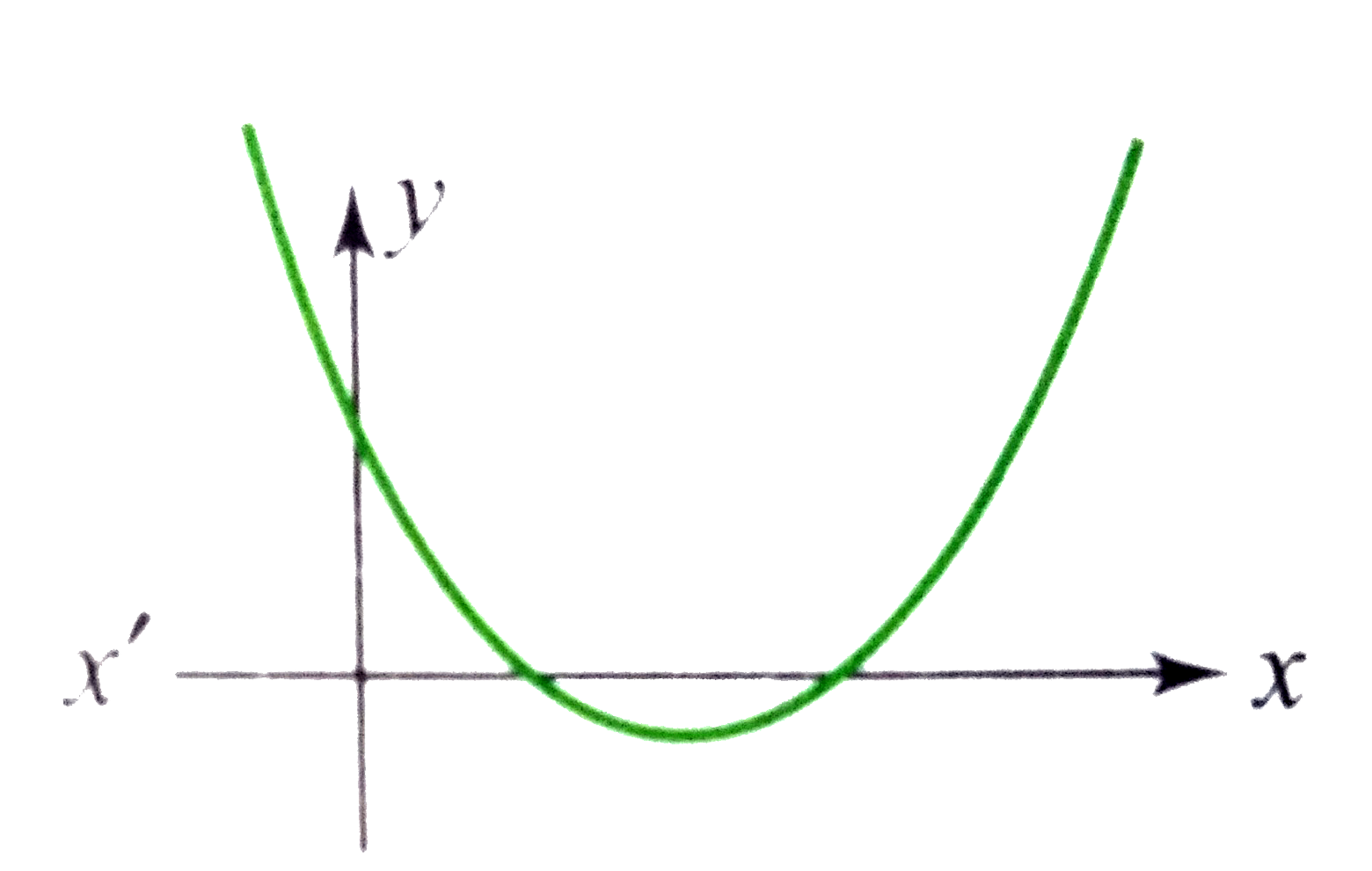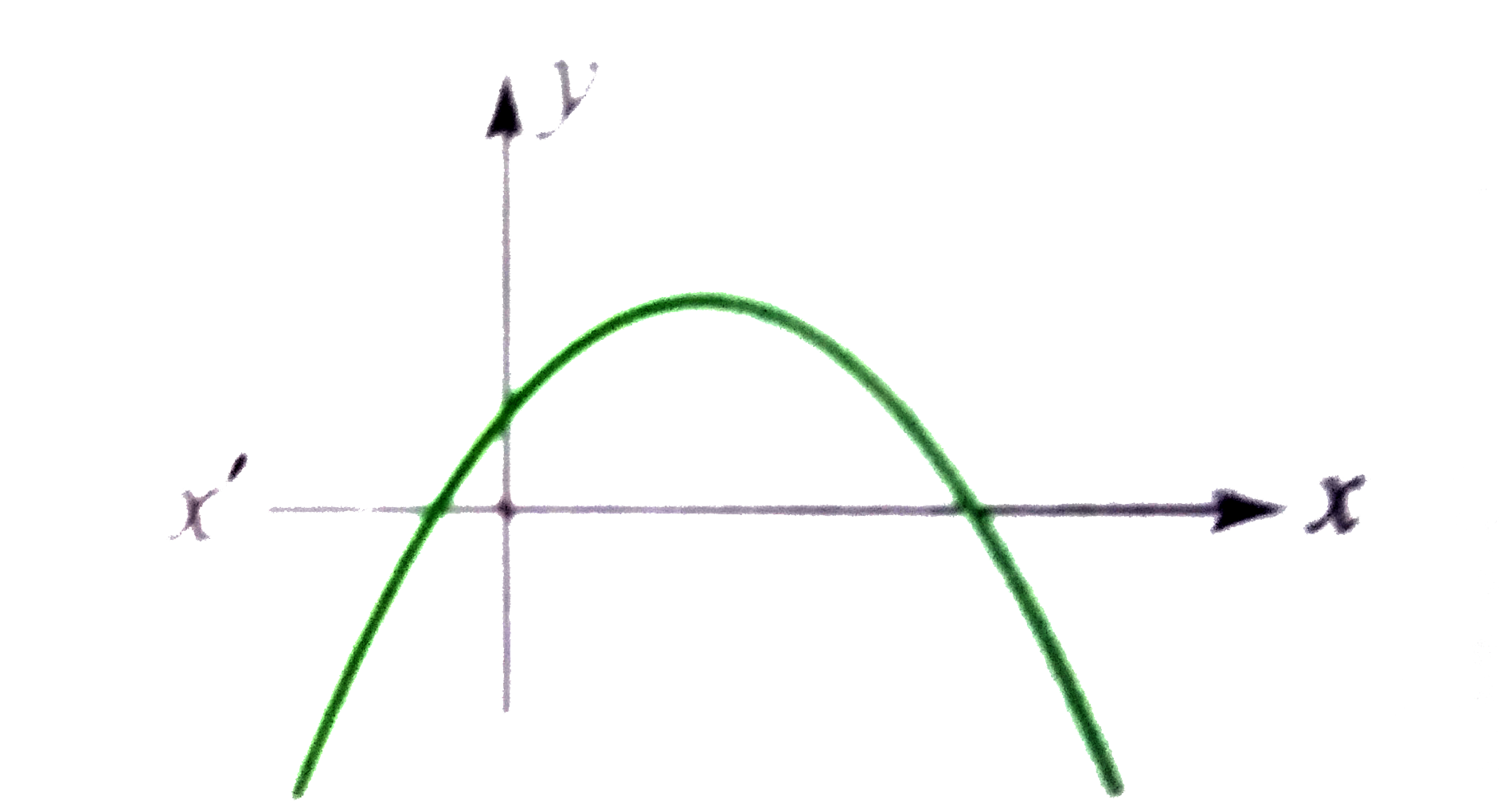Find the value of a for which ax2+(a−3)x+1<0 for at least one positive real x.Solution in Bengali
Let f(x)=ax2+(a−3)x+1
Case I:
If a > 0, then f(x) will be negative only for those value of x which lie between the roots . From the graphs, we can see that f(x) will be less then zero for at least one positive real x, when f (x) = 0 has distinct roots and at least one of these roots is positive.
Since f(0) = 1 > 0, the possible grapha according to the question is shown in the figure. From the graph, we can see that both the roots are non-negative . For this
(i) D>0⇒(a−3)2−4a>0
⇒a<1ora>9 (1)
(ii) sum >0 and product ≥0
⇒−(a−3)a>0ora−3a<0and1/a>0
⇒0<a<3 (2)
From (1) and (2), we have
a ∈(0,1)

Case II : a <0

Since f(0)=1>0, then graph is as shown in the figure, which shows that ax2+(a−3)x+1< 0, for at least one positive x .
Case III : a = 0
If a = 0,
f(x) = - 3x + 1
⇒f(x)<0,∀x>1/3
Thus, from all the cases, the required set of values of a is (−∞,1) .
Topper's Solved these Questions
- BOOK - CENGAGE PUBLICATIONCHAPTER - THEORY OF EQUATIONSEXERCISE - SOLVED EXAMPLES14videos
THEORY OF EQUATIONS
- BOOK - CENGAGE PUBLICATIONCHAPTER - THEORY OF EQUATIONSEXERCISE - CONCEPT APPLICATION EXERCISE 2.13videos
THEORY OF EQUATIONS
- BOOK - CENGAGE PUBLICATIONCHAPTER - THEORY OF EQUATIONSEXERCISE - Multiple Correct Answer6videos
THEORY OF EQUATIONS
- BOOK - CENGAGE PUBLICATIONCHAPTER - STRAIGHT LINESEXERCISE - ARCHIVES (NUMERICAL VALUE TYPE)1videos
STRAIGHT LINES
- BOOK - CENGAGE PUBLICATIONCHAPTER - THREE DIMENSIONAL GEOMETRYEXERCISE - All Questions291videos
THREE DIMENSIONAL GEOMETRY
Similar Questions
IF [x2−2x+a]=0 has no solution, then find the values of a (where [⋅] represents the greatest integer).
02:06View SolutionIf x=1andx=2 are solutions of equations x3+ax2+bx+c=0anda+b=1, then find the value of b.
07:14View SolutionIf c≠0 and the equation p/(2x)=a/(x+c)+b/(x−c) has two equal roots, then p can be a. (√a−√b)2 b. (√a+√b)2 c. a+b d. a−b
05:34View SolutionFor a point P in the plane, let d1(P)andd2(P) be the distances of the point P from the lines x−y=0andx+y=0 respectively. The area of the region R consisting of all points P lying in the first quadrant of the plane and satisfying 2≤d1(P)+d2(P)≤4, is
03:19View SolutionFind the angle between the line whose direction cosines are given by l+m+n=0andl2+m2−n2=0.
02:20View SolutionFind the least positive value of k for which the equation x2+kx+4=0 has real roots.
03:26View SolutionThe set of values of 'a' for which the inequality x^(2)-(a+2)x-(a+3)<0 is satisfied by atleast one positive real x,
03:31View SolutionFind all real value of a for which the equation x^(4)+(a-1)x^(3)+x^(2)+(a-1)x+1=0 possesses at least two distinct positive roots
05:31View SolutionFind the values of the parameter a for which 4^(x)-a.2^(x)-a+3<=0 for atleast one real x.
00:53View SolutionIf the inequality x^(2)+kx+k<0 is satisfied for at least one real x ,then find the smallest positive interaer value of k.
08:36View Solutionk का वह निम्नतम धनात्मक मान ज्ञात करो जिसके लिए समीकरण x2+kx+4=0 के मूल वास्तविक हों।
03:07View SolutionFind the value of a for which ax2+(a−3)x+1<0 for at least one positive real x.
03:58View SolutionFind all real value of a for which the equation x4+(a−1)x3+x2+(a−1)x+1=0 possesses at least two distinct positive roots
05:07View SolutionFind the least positive value of k for which the equation x2+kx+4=0 has real roots.
05:39View SolutionFind the values of k so that the quadratic equation x2 + 2(k-1)x + k+5 = 0 has atleast one positive root.
View SolutionFor real x,the least value of (x-2)(x-3)+1 is___
05:25View Solution

